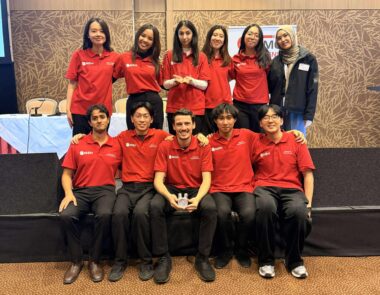Regional and rural communities in Australia have traditionally struggled with the urban-rural divide, facing limited access to services and opportunities that are usually found in cities. Now, there’s a significant change underway aimed at closing this gap and sparking economic growth in these crucial areas. This shift focuses on improving transportation, renewable energy and water infrastructure, and digital connectivity.
Daniel Taylor, Regional Director at CaSE Civil & Structural Engineering, offers valuable insights into the strategies and technologies shaping the future of rural and regional Australia. His perspectives highlight the potential of these infrastructure projects to radically enhance the quality of life in these areas.
Building on the foundation of these infrastructure improvements, the ongoing changes mark the beginning of a new era of possibilities. This effort aims to extend services and opportunities - previously limited to urban centres- across the entire country. This initiative embodies a strong commitment to revitalising regional Australia, ensuring that every community, whether urban or regional, has the opportunity to thrive.
Enhancing transportation networks - the lifelines of connectivity
The development of comprehensive transportation networks is pivotal in Australia’s change agenda. Improved road, rail, and air connections push beyond mere travel conveniences; they are vital for integrating regional Australia with the broader national and global community. Infrastructure Australia’s 2023 Infrastructure Market Capacity report underscores this vision, revealing an extraordinary level of investment in the infrastructure of regional areas across New South Wales, South Australia, and Queensland. According to the report, certain regions are poised to see an average annual investment increase of 75 percent, with some areas experiencing a doubling of investment within a year.[1] This significant uptick in construction activity underscores the immense potential of such projects, aligning closely with the goals of where Australia needs to be.
In parallel, the spotlight on Renewable Energy Zones (REZs), such as the New England Renewable Energy Zone, and transformative infrastructure projects like the Inland Rail, marks a forward-thinking approach to economic revitalisation through green energy and enhanced connectivity. These initiatives are poised to serve as major catalysts for job creation and economic growth in regional communities, further bridging the divide between urban centres and the vast rural heartlands of Australia. By investing in these critical areas, Australia is not only advancing its infrastructure but also committing to sustainable development and environmental stewardship, reflecting a broader shift towards renewable energy and eco-friendly projects.
Daniel Taylor, CaSE Regional Director, echoed the report’s findings, sharing his insights on the impact of infrastructure projects in regional areas. “These projects are not just about building; they represent a fundamental shift towards empowering our regional communities,” Taylor explained. “By providing skilled individuals with the opportunity to engage in significant developments right in their backyard, we’re not just keeping talent local; we’re redefining what it means to ‘build big.’ This initiative is a testament to our commitment to not only drive regional growth but also to challenge the traditional pull towards urban centres. It’s about creating a sustainable future that values the unique contributions of all areas, urban and regional alike.”
For local businesses, agricultural sectors, and the tourism industry, this connectivity is a gateway to expanded markets, enabling regional areas to contribute significantly to national economic resilience and diversity. The investments highlighted by Infrastructure Australia are a clear signal that the path to a more connected and resilient Australia lies through strategic and substantial enhancements to our transportation networks, ensuring that regional communities are not left behind in our nation’s journey towards growth and sustainability.
Digital connectivity - the gateway to modern services
Perhaps no other advancement holds as much promise for transforming life in regional Australia as the improvement of digital connectivity. Broadband and mobile internet services are the gateways through which residents can access vital educational resources, healthcare services, and business opportunities. The Australian Government’s Better Connectivity Plan, earmarking more than $1.1 billion towards enhancing telecommunications in rural and regional communities, underscores this transformative potential. This investment, part of a broader commitment exceeding $2.2 billion in regional communications, aims to revolutionise access to the digital world for remote areas.[2]
Emphasising the indispensable role of digital connectivity in infrastructure development, Taylor said, “Digital connectivity is at the core of modern infrastructure projects, transforming how we approach development in regional Australia. It’s the enabler of sophisticated construction and monitoring technologies that are changing the game - like using drones for land surveying and employing real-time data analytics to oversee large-scale projects. Such advancements are only possible with robust internet services, which are critical for integrating these technologies into our daily operations.”
This integration is driving innovation, empowering regional communities, and bridging the development gap between rural and urban settings. Ultimately, it’s about more than just connectivity; it’s about leveraging that connectivity to make infrastructure development smarter, more efficient, and inclusive for all Australians.”
Community engagement – a cornerstone of sustainable regional development
Community engagement is key in driving sustainable regional development. Speaking recently at the Queensland Media Club about the Future Made in Australia Act, Prime Minister Anthony Albanese emphasised that for Australia to truly prosper and tap into the potential of the next decade, it’s essential that every community is included, involved, and empowered. This extends beyond just being recipients of development but being active participants in shaping it.[3]
To ensure that infrastructure development resonates with the needs of the community, involving local stakeholders in the planning and decision-making process is crucial. This approach aligns with the government’s vision where every community contributes to and benefits from national progress. By soliciting feedback and incorporating local insights into project planning, projects are more likely to meet actual needs and gain community support, enhancing their effectiveness and sustainability.
Echoing the emphasis on job creation and skill development, community engagement in regional development also means prioritising investment in local talent. This involves not only creating jobs through infrastructure projects but also providing training and development programs that equip residents with the skills needed to participate in and benefit from these opportunities. Such initiatives help retain talent in regional areas and reduce the economic disparities between urban and rural regions.
Community engagement also plays a critical role in strengthening community identity and cohesion. As development projects are implemented, integrating cultural and historical elements important to the community can enhance a sense of belonging and pride. This integration can transform infrastructure projects from mere physical constructions into symbols of community strength and resilience.
“Community engagement isn’t just about consultation; it’s about collaboration. As we design and develop infrastructure projects, it’s essential that we bring local voices into the heart of the process,” said Taylor. “By investing in our local communities - creating jobs, developing skills, and incorporating their cultural heritage into our projects- we don’t just build infrastructure; we build a stronger, more unified region. This approach not only meets the immediate needs of the community but also ensures long-term sustainability and resilience, bridging the gap between rural and urban opportunities.”
The future landscape - workforce and supply chain evolution
Looking ahead, the future of regional Australia is promising, yet it faces significant workforce challenges that could hinder its progress. The shortage of skilled labour, particularly in sectors vital to infrastructure development and maintenance, remains a formidable obstacle. Infrastructure Australia’s 2023 Infrastructure Market Capacity report casts a spotlight on this issue, stressing the critical need for engineers, skilled tradespeople, and labourers. It underlines the risk shortages pose to the timely and budget-conscious delivery of infrastructure projects, echoing the concerns raised by industry experts.[4]
Taylor brings a nuanced perspective to this challenge, especially concerning the attraction and retention of professional talent in regional areas. “The key to sustainable growth in regional Australia lies in making these areas appealing to professional couples,” Taylor asserts. This approach addresses the contemporary dynamic where skilled individuals are often part of dual-professional households, looking for opportunities that cater to both their careers. “What the region really needs is to be attractive to two parties,” Taylor emphasises, highlighting the strategic importance of creating job opportunities that appeal to diverse professional backgrounds.
Taylor’s insights align with Infrastructure Australia’s call for a comprehensive national infrastructure workforce strategy. Such a strategy would encompass targeted education and training programs, incentives to retain talent in regional locales, and the leveraging of technology to close the skills gap. These measures are not just about filling vacancies; they’re about nurturing the long-term growth and sustainability of regional communities.
By addressing these workforce challenges with a multifaceted approach, including the specific needs of professional couples, regional Australia can better leverage its infrastructure investments. This ensures not only the economic resilience of these areas but also their continued attractiveness as places to live, work, and thrive. In doing so, the nation can move towards bridging the urban-regional divide, fostering a more balanced and inclusive future for all Australians.”
The strides in infrastructure development signify a brighter future for regional Australia, aiming to narrow the urban-rural divide. By focusing on transportation, renewable energy, digital connectivity, and water infrastructure, the nation is steering towards inclusivity and resilience. This effort is not just about building; it’s about fostering equitable access to opportunities across Australia. Addressing workforce challenges and embracing innovation are key to sustaining this momentum. As these initiatives unfold, they promise to transform regional areas into thriving communities, contributing to Australia’s balanced and prosperous future. This path reflects a collective commitment to ensuring every community flourishes, highlighting the essence of progress and unity.
-ENDS-
[1] https://www.infrastructureaustralia.gov.au/listing/media-release/infrastructure-market-capacity-2023
[2] https://www.infrastructure.gov.au/media-communications-arts/better-connectivity-plan-regional-and-rural-australia
[3] https://www.pm.gov.au/media/future-made-australia
[4] https://www.infrastructureaustralia.gov.au/listing/media-release/infrastructure-market-capacity-2023
About us:
CaSE Civil & Structural Engineering stands as a premier Civil and Structural engineering firm, recognised for delivering innovative, high-quality solutions in global infrastructure projects. Services are organised into four specialised business divisions: CaSE & Pike Design, CaSE Contractors, CaSE Traffic and Transport, and CaSE Commercial. With a global reach extending across 10 offices in Australia, New Zealand, the UK, Europe, North America, South America and the Middle East, a team available 24/7 ensures accelerated delivery of customised engineering solutions. Expertise spans multiple sectors such as Airports, Marine, Rail, Roads, Tunnels, Bridges, Mining, Energy, and Building. A commitment to sustainability underpins all projects, focusing on minimising environmental impact. For more information, visit https://www.case.international/.


